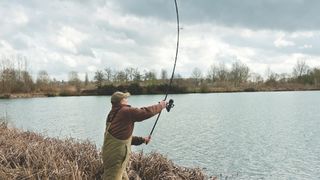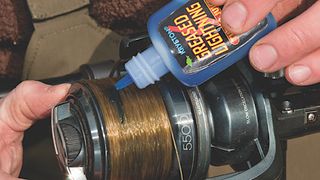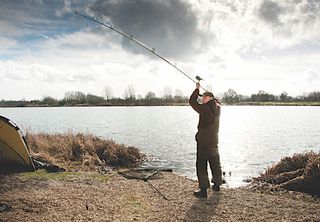How to cast for carp: learn how to cast further
Learn how to cast for carp with our easy-to-follow tips and you'll be casting further, and more consistently, in no time at all

Welcome to Advnture, the new home of AnglersMail.co.uk
Perfecting how to cast for carp is a must for anglers. Most carpers know the frustration of not being able to land a rig quite far enough – whether dropping irritatingly short of a distant island margin or far bank, or not being able to get a rig amongst carp showing well out.
Casting is something we teach ourselves, and given that most of us are never taught the basic principles, it’s no surprise that ability amongst anglers varies drastically.
- How to catch carp: top tips on fishing for this freshwater favourite
- The best carp bait for winter fishing
- Where to fish for big carp: top tips for the best spots in England and Wales
When it comes to learning how to cast for carp, advances in carbon rods, supple, strong and lower diameter reel lines, bigger reels with impeccable line lay and excellent terminal tackle allow us to fish greater distances more easily than ever. But most still exaggerate what they're capable of...
If you're looking to improve your casting skills, the best thing you can do is perfect the basics. Follow our simple steps for casting for carp below and you'll be casting further, and more consistently, than every before.

How to cast for carp: 100+ yards… the right way
Long casting (or just talking about it…) doesn’t make you a hero, it’s all about the end result. Belting leads to the horizon is of no value if you aren’t catching, especially if you'd be catching more sat quietly with baits one yard out.
What most of us need is to be able to fish further on the odd occasion it's required.
Advnture Newsletter
All the latest inspiration, tips and guides to help you plan your next Advnture!
You should be able to fish effectively, and safely at 100 yards and more. Good casters with standard tackle can hit 100 yards with a quality 12 lb main line straight through, but the sheer number of cracked off rigs that I come across leaves me convinced that we need to think about carp and angler safety much more keenly.
With the benefit of reasonable technique and the added security of a knotless tapered leader line, it allows me to fish PVA bags at 100 yards and more – measured against the line clip.
Your arms govern how effectively you compress the blank. If you are bursting blood vessels to get leads out and groaning like a shot putter, the rod isn’t being worked properly, the effort is coming from you.
Your left arm gripping the butt of the blank should be straight and extended, the right arm bent at the elbow so the reel is directly above your head. Being left-handed my arms are the other way around in the picture, but I accept you righties are in the majority and so have used right-handed instructions accordingly.
Check out: Everything you need to know about how to use pellets to catch carp
How to cast for carp: essential carp kit
With the following tips, most should be able to fish bags at these ranges without considering new kit, and most importantly of all, safely.
Long casting is about technique and a fortune on high test curve carbon won’t necessarily help. Years back I trialled distance rods, varying from £100 to three times that. Give or take five yards, I cast the same distance with them all (measured 150-160 yards) because that's what my ability allowed me to do.
Good technique and reasonable tackle casts further than specialist kit with less ability. Your ability is the factor limiting distance, not tackle.
Smaller free-spool style reels will cast a long way in the right hands, but big pits with good line lay result in less line twist and retrieve rigs quicker. I dislike beach size reels, preferring a mid-size with a relatively big spool.
I use 12 ft 2.75 lb rods for pretty well everything, which allows you to fish at 100-120 yards with correct tackle and technique. Stepping up to 3 lb test 12-footers usually gives you a tool with more emphasis on casting, but is only worthwhile if you tackle larger venues regularly. But 50 mm ringing won’t help as much as good technique.
Many waters ban shockleaders, a move I support for carp safety. Tapered mainlines, from several top manufacturers, avoid the need for using a knot which could decrease the rigs safety, with the peace of mind that you are much less likely to crack off on the cast.
For distance work spool with, for example, the Tapered Leader Line that was made by ACE, sees its leader section run from 25 into 10 lb main line or 30 lb to 12 lb. The thicker leader length prevents crack-offs but there’s no knot behind the end tackle to compromise rig safety.
If you want extra distance without the worry of a leader, please take this knotless alternative. Choose the 10-25 lb version for maximum range, the 30-12 lb giving security of a standard main line for durability with the casting peace of mind of the stronger leader.
Check out: How to catch carp in winter

A lubricant liquid squirted on the spool, allows it to disappear from the reel and through the rings with reduced friction.
At £7 per bottle it’s cheaper than new rods and improves life of your line and abrasion resistance into the bargain. It encourages line to float so you’ll take a few seconds more to sink your reel line but it makes a significant difference to the distances you achieve.
You’d be surprised how some bombs tumble or wobble in flight. The only choice for maximum distance is a streamlined distance pear lead. These pointed, bullet shaped bombs cast noticeably better than any other design.
Slender bombs offer reduced bolt effect when a carp tightens a link, but if you can’t get the hook bait in front of fish you aren’t catching anyway. It’s always a trade off, with getting a bait in front of carp the most important factor.
With tapered leader line I avoid leadcore – perversely the high diameter of the leader line results in a bulky knot, which is a potential danger. Snip the swivel from a distance lead or shroud it in a silicone sleeve to prevent tangling around the lead. A quick change ring swivel and rig sleeve allows instant replacement of rigs.
A hook bait plus a pinch of pellets is more attractive than a hook bait alone. The resistance of a bag costs you distance, but eliminates tangles even with long hairs.
Keep bags as small as you can, marble size is enough, or distance really suffers. If you can’t reach with a bag, drop it and use a length of tubing behind the clip and fish hook bait only.
With the bomb tied to the end of the line helicopters fly brilliantly. For helicopters and big chucks use tubing not leadcore, because of the implications of a bulky knot tying the higher diameter leader section of line to leadcore.
Tubing is safer – in event of a crack off, a tubing rig falls apart leaving the carp just trailing a short link.
Helicopter rigs at any range cannot be used with cobweb bags. They are a hook bait only end tackle.
Check out: Carp floats: everything you need to know

How to cast for carp: tips to help you launch the BIG chuck
The further out you fish the more delayed your indication, line being strung through 100 yards of water, weed, undertow and across obstacles.
Bobbins need to be fished clipped up and fitted with additional drag weights. Distance work is no place for slack lines. The best indication is when bobbins hang on a natural drop.
With running lead clip end tackles you should get line tighteners or spool spinners, but bobbins hanging on a short drop remain the best choice.
Check out: How to catch carp on bread
Most Popular

